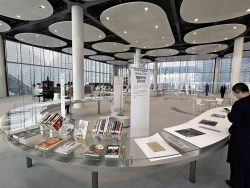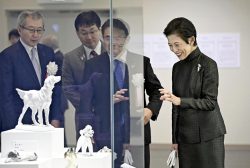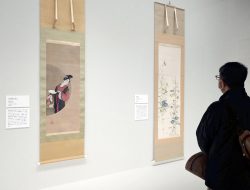
“Rakuchu-Rakugai-zu Byobu: Iwasa Matabei RIP,” right, and other Murakami works are seen at the “Takashi Murakami Mononoke Kyoto” exhibition at Kyoto City Kyocera Museum of Art on Feb. 2.
14:00 JST, May 26, 2024
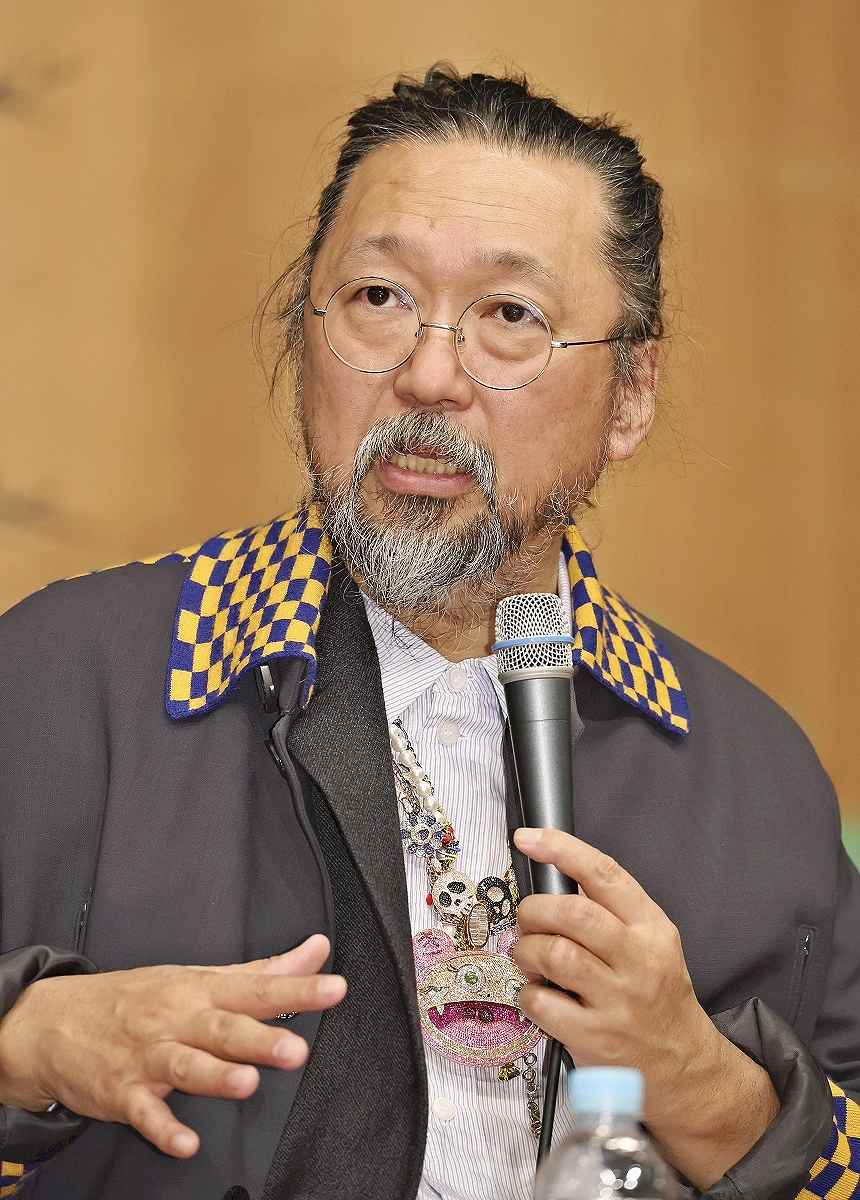
Takashi Murakami speaks about his works at a press conference in Kyoto in November.
KYOTO — Takashi Murakami’s light and colorful works seem to jump out at the viewer with an overwhelming fervor, linking the early modern period of Japanese painting to the present.
His solo exhibition, “Takashi Murakami Mononoke Kyoto,” is being held at the Kyoto City Kyocera Museum of Art. The contemporary artist has been incredibly active overseas, but this is his first large-scale exhibition in Japan in about eight years.
“I think there are around 50 truly discerning art appreciators, collectors and production professionals in the world. I’m trying to create the best works I can, so that I can throw an overpowering fastball at them,” said Murakami, 62, showing confidence at a press conference before the exhibition’s opening.
Murakami’s large painting, based on the national treasure “Rakuchu Rakugai-zu” or Scenes in and around Kyoto (Funaki version) by Iwasa Matabei, is displayed at the entrance of the exhibition hall.
Murakami’s “Rakuchu-Rakugai-zu Byobu: Iwasa Matabei RIP,” which measures 2.3 meters in height and 13 meters in width, depicts a bird’s-eye view of the city, including a festive atmosphere with the city’s residents singing and dancing, surrounded by magnificent, skull-filled golden clouds.
Murakami has challenged the Western art world by incorporating the flat expressions found in traditional Japanese paintings, manga and anime into his work, which he calls “superflat.”
In a single painting, the freedom and joy of expressing everything flatly coexist with the fragility of the city, which has always been caught between life and death.
As one moves past the Rakuchu-Rakugai-zu Byobu painting, a dark room comes into sight.
Four paintings there truly stand out, each measuring 5 meters in height and width, depicting four images — the blue dragon, the white tiger, the vermilion bird and the black tortoise. These four symbols, or shijin mythological animals, are depicted as friendly characters.
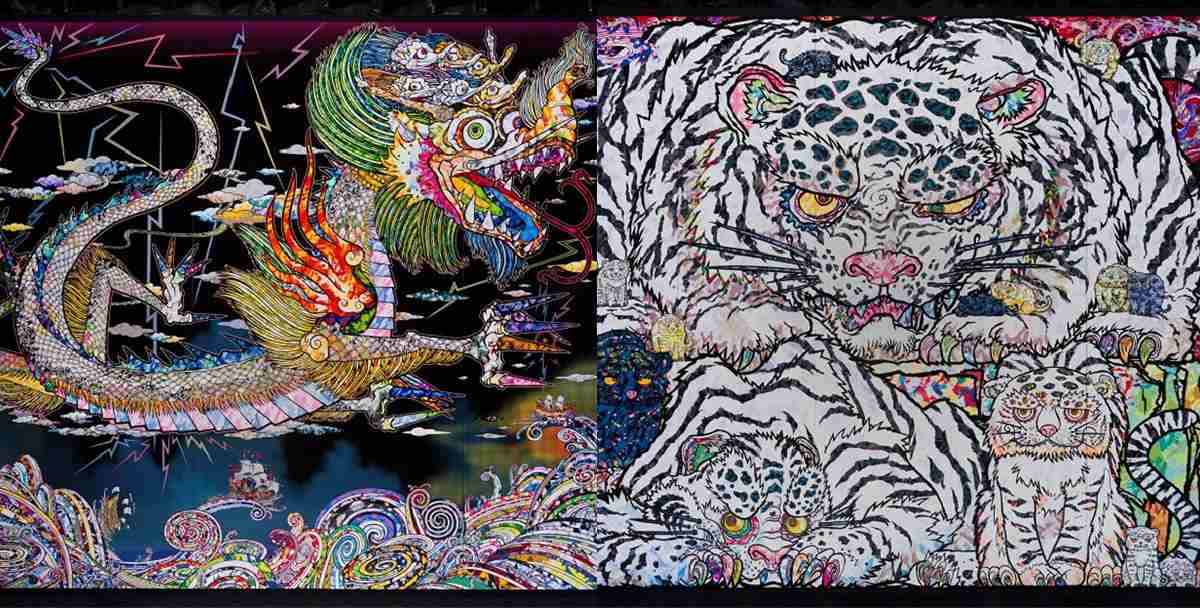

Clockwise from top left: Blue Dragon Kyoto, White Tiger Kyoto, Vermilion Bird Kyoto, Black Tortoise Kyoto
Heiankyo, the ancient capital of Japan, is said to have been built with these four symbols as protectors of the land.
The pair of “Wind God” and “Thunder God” paintings that greet visitors in the “Wind God and Thunder God Wonderland” room demonstrate what Murakami’s works are really about.
While Murakami follows in the footsteps of giants such as Tawaraya Sotatsu, he depicts the Wind God and Thunder God with a manga-like looseness.
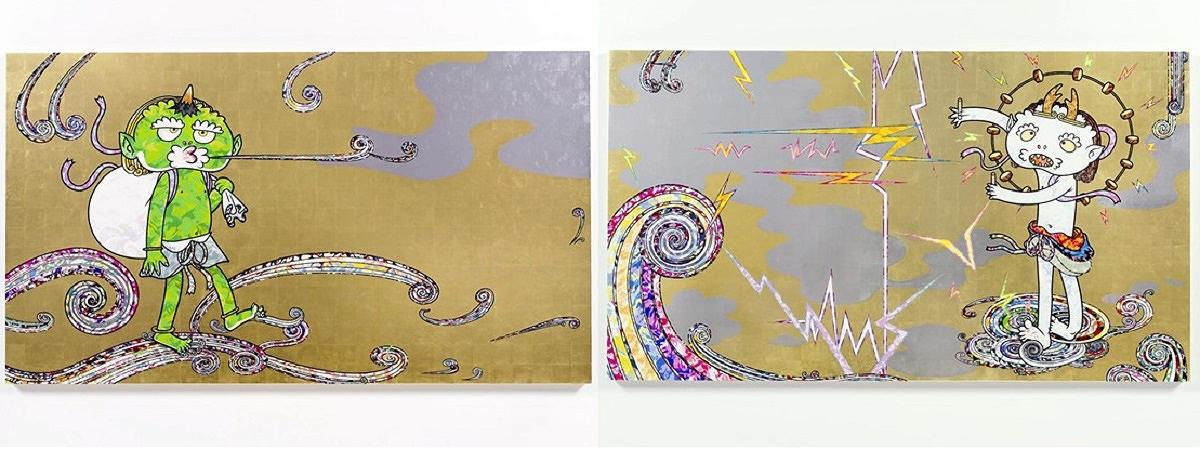
“Wind God” left, and “Thunder God”
Murakami has said that the goal of his work is to “break free from the consciousness of expression and enter a state of emptiness.” He says that these are works he can say he is proud of and that they are an achievement.
Murakami’s “Wind God” and “Thunder God” paintings are full of looseness and innocence, in contrast to the fierce appearance seen in the Sotatsu paintings drawn in the turbulent past.
Murakami moved to Kyoto after the 2011 Great East Japan Earthquake. He had planned for his previous Tokyo exhibition in 2015-16 to be his last in Japan, but he established a base of creative activities in Kyoto and found new inspiration there.
It was Shinya Takahashi, the museum’s general manager and an old acquaintance, who encouraged the reluctant Murakami to hold the exhibition.
In the ancient capital, where rich pictorial expression styles such as the Tosa, Kano and Rimpa schools flourished, the glittering culture overlapped with its past of warfare and epidemics.
Takahashi said he told Murakami to create artworks that would “unearth the ancient city, with places covered in the dead, which has become a tourist attraction.”
“I create my work in the belief that it can change the world. The act of looking at a painting is a cultural experience that cannot be replaced by anything else,” Murakami said.
Kyoto is a mixture of the sacred and the profane, this world and another.
The ancient capital of Kyoto, which is now filled with foreign visitors, has made a new name for itself around the world as a spiritual center of contemporary art.
Supporting the arts
Takashi Murakami Mononoke Kyoto consists of six sections, with the majority of the roughly 180 works being new productions exhibited in Japan for the first time.
One of his new works “Dragon in Clouds — Red Mutation,” a work based on those of the Edo period (1603-1867) painter Soga Shohaku, is being exhibited for the first time in Japan. “DOB,” a character that represents the artist’s philosophy, and his other new works, redesigned versions of his earlier art, convey who he has become.
His efforts to use the furusato nozei hometown tax donation system in cooperation with the city of Kyoto for the exhibition created a stir among Japan’s cultural authorities, which have provided little support for the arts sector.
Murakami decided to give away a special trading card he designed as a gift, along with other items, in return for the donations.
The donations have allowed the museum to offer free admission for high school, university and vocational school students who live or attend school in Kyoto. The exhibition will last until Sept. 1.
"Culture" POPULAR ARTICLE
-

Van Cleef & Arpels Dazzles with Art Deco Artisanry at Tokyo Exhibit
-

Disney’s ‘Twisted-Wonderland’ Animated Series Puts Villains in Spotlight: New Show Features School Inspired by Classic Disney Films
-

Ayumi Hamasaki’s Shanghai Concert Canceled Day Before Schedule as Part of Beijing Backlash
-

‘The World Masterpiece Theater Series’ Celebrates 50 Years; Animator Looks Back on Creating Anime Classics
-

Popularity of Piggy Banks Across Time and Place Seen at Bank’s Museum of Money Boxes in Hyogo Pref.
JN ACCESS RANKING
-

Tokyo Economic Security Forum to Hold Inaugural Meeting Amid Tense Global Environment
-

Keidanren Chairman Yoshinobu Tsutsui Visits Kashiwazaki-Kariwa Nuclear Power Plant; Inspects New Emergency Safety System
-

Imports of Rare Earths from China Facing Delays, May Be Caused by Deterioration of Japan-China Relations
-

University of Tokyo Professor Discusses Japanese Economic Security in Interview Ahead of Forum
-

Japan Pulls out of Vietnam Nuclear Project, Complicating Hanoi’s Power Plans


